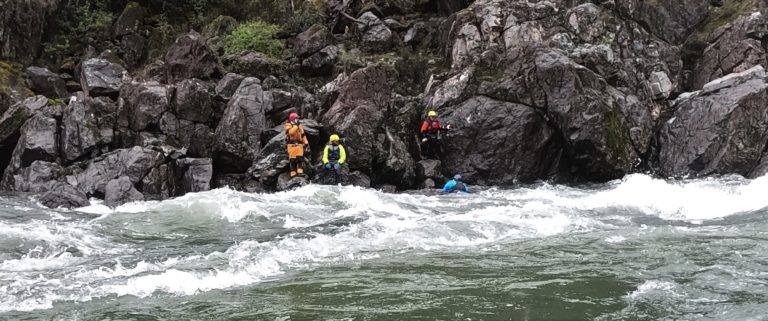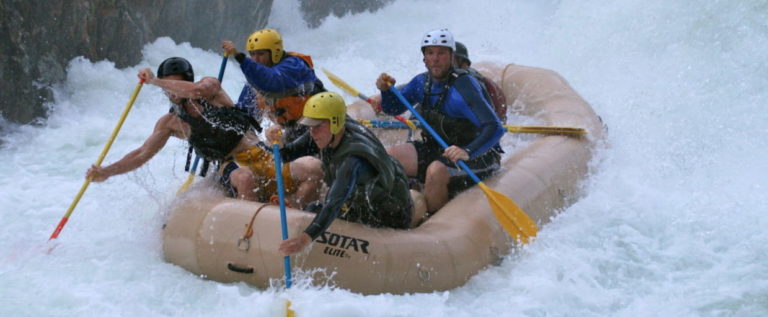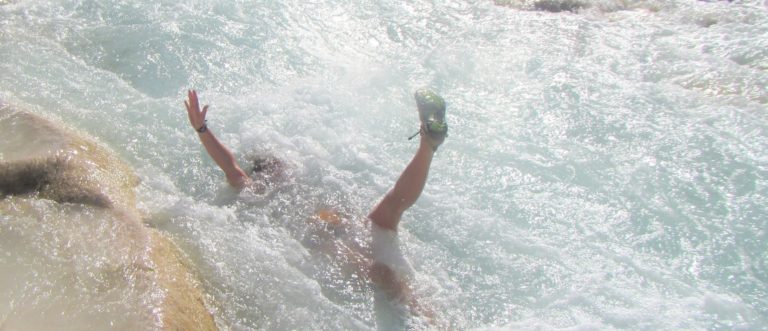There are variables to consider when purchasing a whitewater raft: design, size, cost, materials, and type of usage. People tend to focus on the size (particularly length). However, raft performance depends heavily on raft materials (scroll to materials) and design. In this post we are going to break down these variables along with what different manufactures offer to help you figure out the right inflatable raft for you. We also have a post on the different types of whitewater crafts.
Variables of Raft Design
Raft Length
People tend to spend the most time considering length which is a good place to start. The length of a raft dictates its width, weight and capacity.
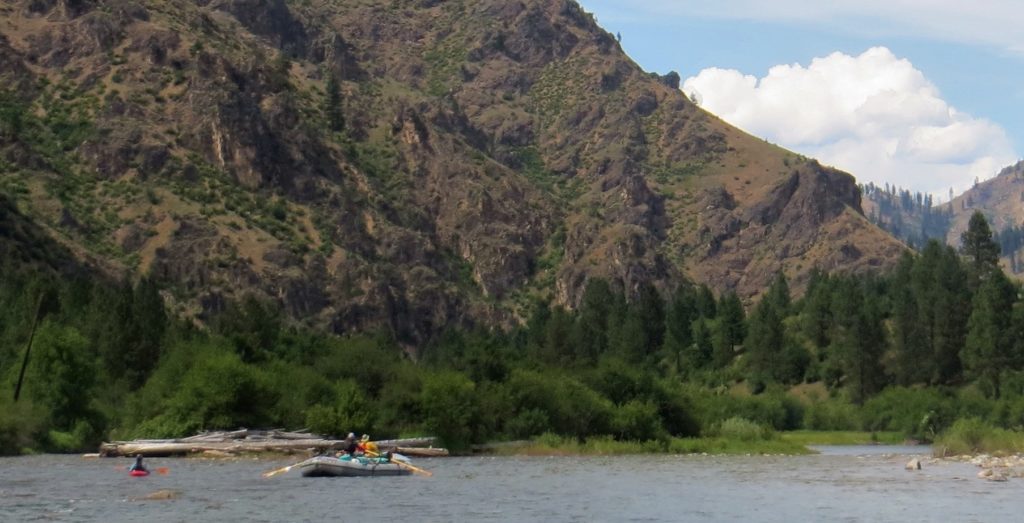
18 foot Rafts
The main advantage of 18 foot rafts is their ability to carry tons of gear and their stability in high volume rivers. They also draft less water which helps in broad shallow runs. Disadvantages include being less maneuverable, heavy, take up lots of space in your garage, more expensive, and terrible for paddle boating and R-2ing.
16 foot Rafts
16 footers can still carry a bunch of gear and fit through tight slots better than 18 footers, Still challenging to run as a paddle boat but are great high water oar-paddle combo rafts with up to 6 paddlers. In general they are more useful as a multi-day raft except for those needing to carry (literally) tons of gear and people.
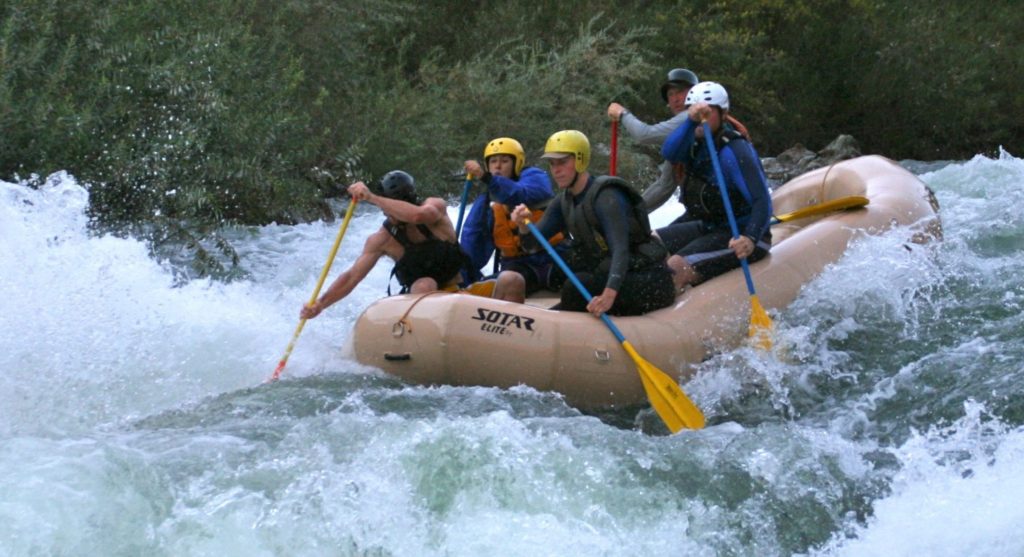
14 Foot Rafts
Fourteen foot rafts are the classic paddle raft for 6 people and a guide. They also can still be run as a gear raft but are easy to overload. These boats are fun to row with just a rowing frame. When run as an oar/paddle they are best with 4 paddlers and do pretty well on high volumne rivers. They can also fun to R-2.
12 Foot Rafts
Twelve foot rafts are best for paddle boats with 4 paddlers, R-2ing or running with a small rowing frame. They can work as a solo gear boat with minimal gear. These also work great as a multi-day R-2 raft with a dry bag in the front and back compartment. Anything smaller than a 12 footer is best for R-2ing or solo rowing.
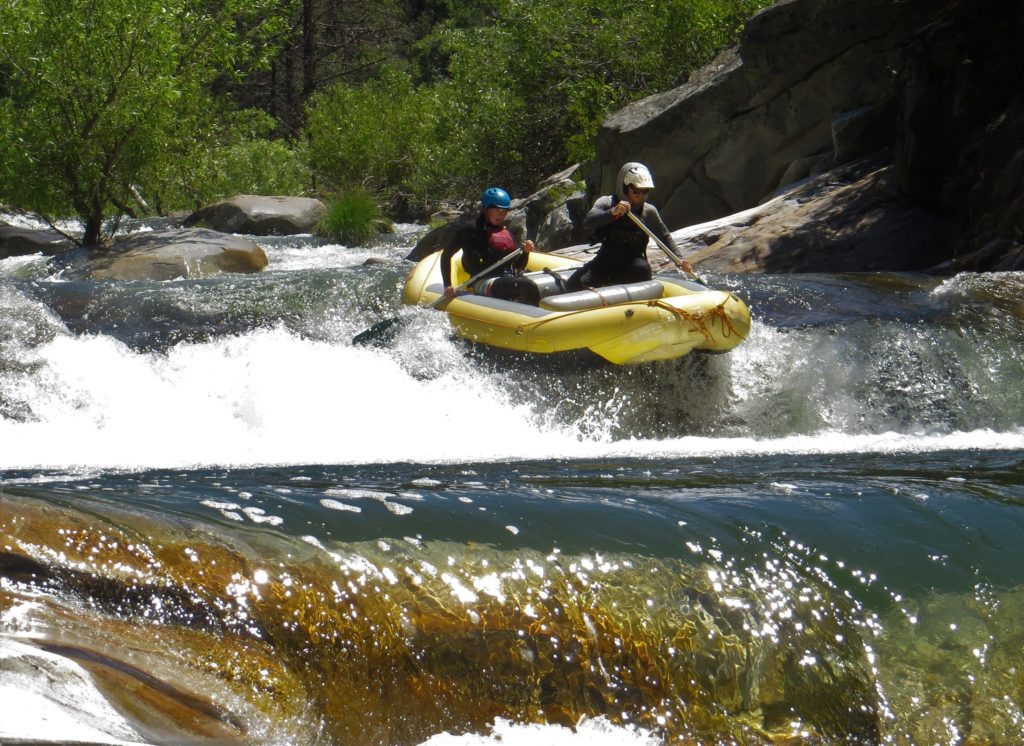
Inflatable Kayaks and Packrafts
Inflatable Kayaks/Packrafts: these craft are outstanding for one person on low volume rivers. If river runners pack light it is possible to to a week plus self-support trip out of them.
Types of Floors
There are two main variables with floors. Choosing between an I-beam and drop stitch floor and whether the floor is glued or laced to the raft. As we will discuss they each have their places.
I-beam
I-beam floors are much more common these days. Most of the companies (NRS, SOTAR, Hyside, Wing, Avon) use I-beam floors. The floor will have creases about ever 6 inches running the length of the floor. I-beam floors track well, meaning they float in the direction they are pointed.
Drop Stitch
Drop stitch floors are flat. Without the creases they don’t track as well, get surfed off of wave trains more often and are easier to move laterally. The main advantage of a drop stitch floors like in the Maravia is that it does have a pressure relief valve to leak and get full of sand so there is no need to re-inflate your raft every morning.
The drop stitch floors also are dryer for standing in which is nice for multi-day trips when need to get in and out of the rafts at night.
Water Ballast Floors
Aire rafts have a unique system with an inner bladder on their floors. With the two layers of material there is a space that fills with water. They sell it as water ballast. Some people swear by them.
The rafts are more stable this way but they are also more sluggish particularly with their bigger rafts. When pulling the raft out of the water it is best to wait to let the water drain out so the raft is much lighter to carry.
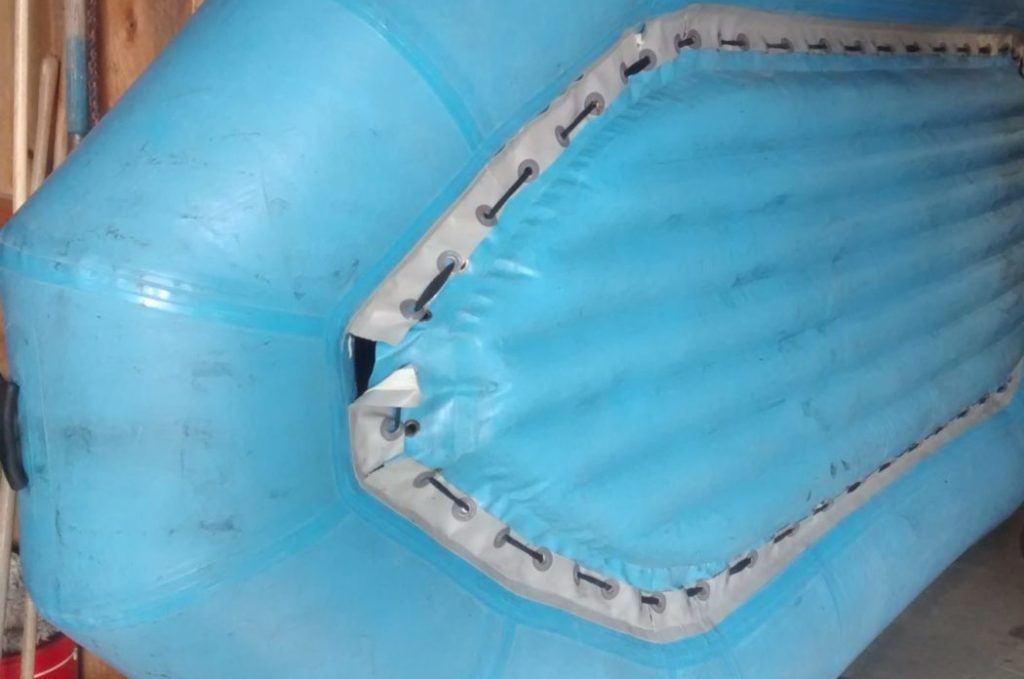
Glued versus Laced in Floors
Laced floors have a piece of webbing that laces the floor into the bottom of the raft. These floors are replaced more easily or can be removed to send back to be fixed. They also drain more quickly than glued in floors. Another advantage for traveling is unlacing the floor makes the outer tube much lighter for carrying on a plane or down a trail into a remote canyon.
The disadvantages are the webbing wears out and can break. Relacing a floor is an annoying time consuming process. Laced floors typically move slower than glued in floors in the river due to the two pieces (some times three) of material on the bottom. The protective floor flap catches on rocks when going over drops and gets ripped off over time.
Glued in floors make the raft lower maintenance and cleaner along the bottom. However, if something goes wrong with the floor the whole raft has to be sent in for repair.
Raft Design
The key components of raft design are rocker, tube diameter, and whether to have diminishing tubes. These three variables in combination with the materials, length, width, and floor type have the largest influence on how the inflatable raft performs.
Tube Diameter
For the moment we are talking about tube diameter along the sides of the raft. Diameter in the bow and stern will be broken down when we discuss diminishing tubes.
A larger tube diameter (22 inches) in general makes a raft more stable and comfortable to sit in. However, as the tubes get larger the raft has to either get wider which can cause performance issues and make it challenging to slip between rocks or the raft looses internal space making it more challenging to fit gear and people in the raft.
Smaller tube diameters have some advantages. It is easier to climb back into the raft from the water. It is also easier to get gear in and out of the boats. Finally rafts with smaller tubes are generally more exciting and splashy.
Diminishing tubes
A diminishing tube is where the tube size gets smaller as it gets to the stern and bow of the raft. Some people like this and feel like it makes the raft knife through waves better. This can be true depending upon the rocker of the raft which we will discuss next.
Rafts with minimal rocker and a 22 inch front tubes get stopped easily and turned sideways in large waves. However, big tubes are much more stable going over big drops, particularly at an angle.
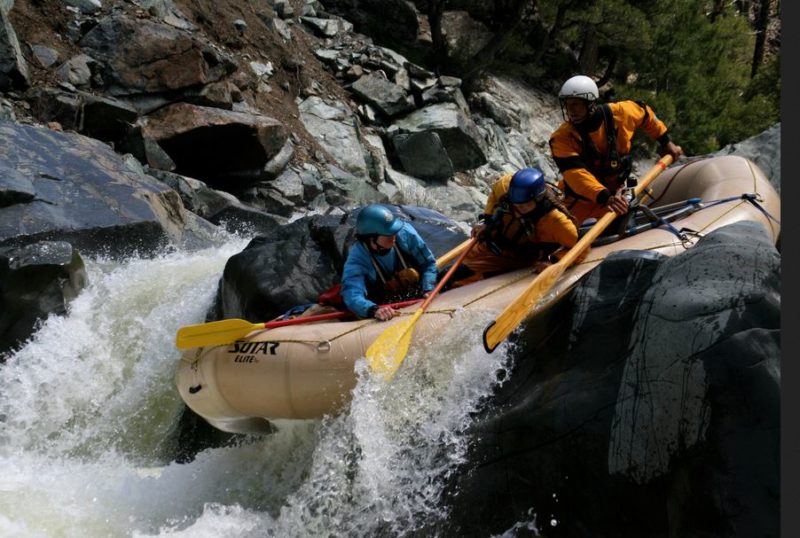
Rocker
Rise in the stern and bow of the raft is called the rocker. There are two components to rocker: the amount of lift in the bow and stern as well as at what point the lift starts.
Boats with more rocker tend to pop over the top of waves. Rafts with less rocker stop and surf more when hitting waves. Rocker helps a raft keep its momentum in the desired direction and minimize the likelihood of a raft being turned sideways in waves. More rocker also means less of the raft is in the water making it easier to turn the raft.
On steep rivers the extra rocker can be a disadvantage as rafts gain more speed quickly giving less time to make moves. They also tend to be a little less stable over drops particularly when combined with diminishing tubes.
Boats with less rocker tend to be faster on flat water. Like longer rafts, they draft less water making them better in shallow rivers. They are much easier to get gear in and out of when going over the nose and stern. Some rocker is nice on most whitewater rafts. On high volume rivers I’m a big fan of major rocker on big rafts.
For example on the Futaleufu River we ran 18 foot rafts. Each generation of raft had more rocker than the previous and the newest ones performed by far the best.
Raft Materials
Three main rafting materials are polyvinyl chloride (PVC), polyurethane (also called urethane) and Hypalon. All 3 materials can be used to make are high quality inflatable rafts. The materials start with a fabric base that is covered by a unique synthetic rubber like substance. Sanding the final material will cause the fabric base to start to show.
Polyurethane Material
There is some confusion about polyurethane versus urethane. Sotar and Wing rafts use polyurethane. Polyurethane is made of urethane molecules so when they are called urethane boats it is not incorrect but it isn’t really correct either.
Polyurethane rafts tend to be the most rigid of the three materials. This means rafts are less likely to wrap on a rock but more likely to flip. Polyurethane produces the highest performing rafts for this reason. They also slide over rocks well. Due to these traits urethane rafts are ideal for steep rocky rivers.
Due to being stiff, urethane rafts are more difficult to roll. They are also more difficult to field repair but warehouse and factory repairs can be done by heat welding making for extremely strong patches. (Tear Aid is an excellent option for field repairs.)
In general polyurethane is more tear and puncture resistant then other raft materials, allowing for lighter rafts that are stronger. However, polyurethane comes in different deniers (think of thicknesses) and if a raft is made with a thin enough denier, Hypalon and PVC could be stronger.
I’ve seen problems with pinhole leaks on floors of polyurethane rafts from wear over time most likely from rocks and dirt on bottom of shoes. This isn’t such a problem with Hypalon rafts.
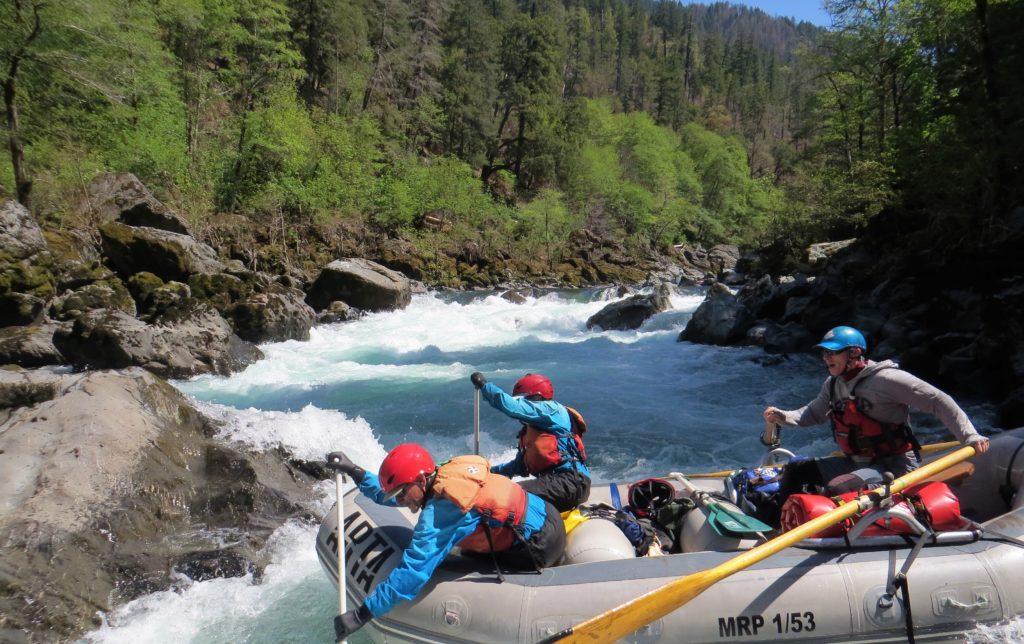
Hypalon
Most commercial rafting companies use Hypalon rafts. Hyside and NRS are the best two retailers of Hypalon rafts. The material costs less than polyurethane. Rafts made of the material roll easier and get less holes worn in them while being transported rolled up.
Hypalon material is softer which means the rafts aren’t as rigid. They provide a softer ride and are much less likely to flip than urethane rafts but can wrap much worse than urethane boats. They are easier to repair in the field and the material lasts the best over time. There are many 20+ year old Hypalon rafts still in use by commercial outfitters. Urethane and PVC do not last as long.
PVC (polyvinyl chloride)
PVC is less expensive the than other two materials, it doesn’t hold up as well and is typically used with cheaper mass produced rafts. The material is known to be brittle in the cold and wear out quickly when exposed to UV light. Talk to raft repair companies and they are not fans of these boats. The big advantage is that they are cheap!
Raft Material Combinations
A couple of companies combine materials. Maravia makes a raft out of PVC and then covers it in Urethane (actual urethane not polyurethane). The urethane is tough and good in UV. It also slides over rocks well. It can be a little tricky to prep a surface to repair. The other major con is these boats are difficult to roll.
AIRE rafts are the reverse with a urethane coated bladder inside a PVC shell. AIRE boats don’t have to worry about the UV degradation of the PVC outer shell causing the raft to leak because of the inner bladder.
Final Thoughts
We have discussed the major factors to consider when selecting a raft. However there are other variables to consider. If you live close to a manufacturer it is nice to be able to drive your raft to the shop to have it fixed. At some point most rafts need some work done. Shipping a raft can be a pain and having a local shop that is familiar with your raft leads to more consistent outcomes.
In general, it is best to have the smallest raft that will work for you. Smaller boats work better to carry/pack/store, fit through smaller channels, and are more fun paddle rafts. Most of the time, it is easier to take a smaller raft on a big river than a bigger raft on a small river. Learn about different types of rafts.
